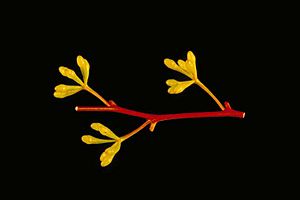Shiny-leaved ironbark facts for kids
Quick facts for kids Shiny-leaved ironbark |
|
|---|---|
 |
|
| Flower buds of Eucalyptus virens | |
| Conservation status | |
| Scientific classification | |
| Genus: |
Eucalyptus
|
| Species: |
virens
|
The Shiny-leaved Ironbark (scientific name: Eucalyptus virens) is a special type of tree. It is found only in Queensland, Australia. This tree is known for its tough, dark bark that looks like iron. It also has shiny green leaves. It is usually a small to medium-sized tree.
Contents
What the Shiny-leaved Ironbark Looks Like
The Shiny-leaved Ironbark tree can grow up to 25 meters (about 82 feet) tall. It has a special woody lump at its base called a lignotuber. This helps it regrow after fires or damage.
Its trunk and branches are covered in rough, grey to black bark. This bark is deeply grooved, like the surface of iron.
Young plants and new shoots have glossy green leaves. These leaves are shaped like a spear and are about 4 to 7 centimeters (1.5 to 2.7 inches) long. They are about 1 to 1.6 centimeters (0.4 to 0.6 inches) wide.
Older leaves are also shiny green on both sides. They are narrow and spear-shaped. These leaves are about 5.5 to 11 centimeters (2.1 to 4.3 inches) long. They are about 0.9 to 2 centimeters (0.3 to 0.7 inches) wide. Each leaf has a stalk called a petiole, which is about 1 to 2.2 centimeters (0.4 to 0.8 inches) long.
The tree's flower buds grow in groups of seven. They are found at the ends of the branches. Each group of buds sits on a main stalk called a peduncle, which is about 0.6 to 1.5 centimeters (0.2 to 0.5 inches) long. Each individual bud has its own small stalk called a pedicel, about 0.2 to 0.5 centimeters (0.07 to 0.19 inches) long.
Mature buds are oval-shaped. They are about 0.5 to 0.6 centimeters (0.19 to 0.23 inches) long and 0.4 to 0.5 centimeters (0.15 to 0.19 inches) wide. They have a cap, called an operculum, that can be cone-shaped or rounded.
These trees have been seen flowering in February. Their flowers are white. After flowering, they produce woody, half-round fruits. These fruits are called capsules. They are about 0.4 to 0.6 centimeters (0.15 to 0.23 inches) long and 0.4 to 0.7 centimeters (0.15 to 0.27 inches) wide.
How it Got its Name
The Shiny-leaved Ironbark was first officially described in 1987. Two scientists, Ian Brooker and Anthony Bean, wrote about it in a science journal called Brunonia. They found the first samples of this tree near a place called Injune in 1975.
The scientific name virens comes from a Latin word. It means "green." This name was chosen because of the tree's bright green leaves.
Where it Lives
The Shiny-leaved Ironbark grows in open forests. It prefers sandy soil on flat areas and gently rolling hills.
You can only find this tree in three small areas in south-eastern Queensland. These areas are near the Maranoa River, Tara, and Inglewood.
Conservation Status
This special eucalypt tree is considered "vulnerable." This means it is at risk of becoming extinct if we don't protect it. Both the Australian Government and the Queensland Government have laws to protect it.
The biggest dangers to the Shiny-leaved Ironbark are:
- Timber harvesting: Cutting down trees for wood.
- Habitat loss: Clearing land for other uses, which destroys the places where these trees live.
Images for kids



